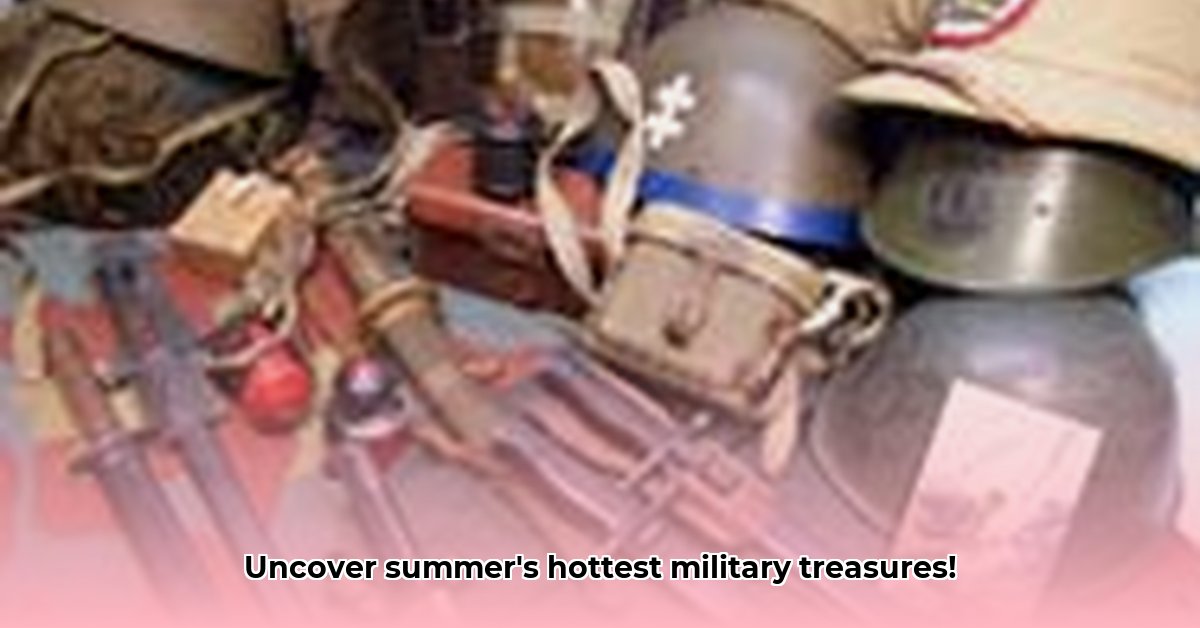
Unearthing History: A Collector's Journey
Summer vacation – a time for relaxation, adventure, and the thrill of discovery. Imagine unearthing a piece of 20th-century military history, a tangible link to the past, during your summer travels. This isn't just about dusty artifacts; it's about connecting with history firsthand, a captivating hobby that blends leisure with learning. This guide will equip you to navigate the fascinating, yet sometimes complex, world of military memorabilia collecting, whether you're a seasoned enthusiast or just beginning your journey.
A Collector's Guide to 20th-Century Militaria
The market for 20th-century military collectibles is vast and varied, ranging from uniforms and helmets to rare documents and deactivated weaponry (ensure legal deactivation before acquiring any weaponry). Popular niches, like World War II German items, command high prices, but the field offers much more than just iconic pieces. Lesser-known conflicts and military units provide unique collecting opportunities. However, this dynamic market fluctuates, influenced by trends and availability. Patience, knowledge, and careful discernment are crucial for success. Isn't it intriguing how a small, seemingly insignificant item can hold such a profound connection to a pivotal moment in history?
Building Your Collection: A Step-by-Step Guide
Ready to begin? Let's explore a structured approach to responsible and rewarding collecting:
Step 1: Define Your Focus. Don't aim for everything; specialize! Select a specific era, branch of the military, or geographical location that sparks your passion. This focused approach streamlines research and enhances your understanding of the artifacts.
Step 2: Authenticity Verification: The Cornerstone of Collecting. Counterfeit items are prevalent. Develop a keen eye for detail. Carefully examine markings, materials, and wear patterns. Do they align with known manufacturers or military units? Are any aspects too "perfect"? Consult reputable online resources and reference books for comparison. Seek expert opinions from established dealers or experienced collectors to verify authenticity before making a purchase.
Step 3: Ethical Collecting: Respecting the Past. Research the provenance (history of ownership) of any item. Ensure that the artifact's acquisition was ethical and legal, avoiding items with problematic origins. Responsible collecting respects the human stories behind the objects. Do you agree that understanding the history and context of these items significantly enhances their value and meaning?
Step 4: Sourcing Your Treasures. Explore various avenues: military shows and auctions offer unparalleled opportunities to connect with fellow enthusiasts and discover unique items. Online platforms broaden your reach but demand extra caution. Thoroughly vet sellers and request high-quality images before committing to a purchase.
Step 5: Preservation: Protecting Your Collection. Proper storage prevents deterioration. Keep items in a cool, dry environment, away from direct sunlight and humidity. Handle items gently, employing professional conservation services for delicate pieces. Investing in proper preservation protects your investment and preserves historical integrity. Did you know that an improperly stored item can lose significant value due to damage?
Step 6: Investment Strategies (Supplemental). While some memorabilia appreciates in value, prioritize passion and historical interest. Market trends are unpredictable; smart collecting is about more than just financial return.
Challenges and Opportunities in the Market
The field presents challenges: verifying authenticity remains paramount, and market fluctuations impact values. However, informed collecting offers significant rewards:
| Challenge | Opportunity |
|---|---|
| Counterfeit Items | Hone your authentication skills; seek expert advice. |
| Market Fluctuations | Specialize in a niche area to mitigate broad market volatility. |
| Ethical Sourcing Concerns | Build a collection that reflects responsible and ethical collecting practices. |
The Future of Military Memorabilia Collecting
The future of military collecting depends on responsible practices and continued historical interest. The market will likely remain dynamic, influenced by emerging technologies, evolving historical perspectives, and a sustained fascination with the past. What are your thoughts on the future of this field?
How to Authenticate 20th-Century Military Memorabilia Effectively
Key Takeaways:
- Authenticity, provenance, and condition determine value.
- Counterfeits are commonplace; thorough examination is vital.
- Responsible collecting values ethical sourcing and preservation.
- Market trends influence investments; research is essential.
- Online resources and reputable dealers aid authentic item discovery.
Mastering Authentication: A Practical Guide
Authenticating military memorabilia requires a keen eye and a methodical approach. This isn't just about acquiring an item; it’s about understanding its history and significance.
Visual Inspection: Meticulously examine inconsistencies in markings, materials, and wear. Counterfeits often lack the subtle imperfections of genuine artifacts.
Material Analysis: Research authentic materials and construction methods specific to the era. Discrepancies indicate potential reproductions.
Markings & Insignia: Verify markings against known manufacturers or units. Forged markings are a common indicator of counterfeits.
Provenance Research: Trace ownership history. Documents like letters of authenticity support genuineness.
Expert Consultation: Consult a professional appraiser when uncertainty exists. This is an investment that pays off in the long run.
Ethical Considerations: Always ensure ethical and legal acquisition. Avoid items with problematic origins.
Finding Items: Explore flea markets, online platforms, auctions, and military shows, always exercising caution.
Preservation: Store items appropriately to preserve their condition and value.
Navigating Market Challenges and Opportunities
Market dynamics impact the value of collectibles. Economic shifts influence demand, while the prevalence of counterfeits requires vigilance. Conversely, the internet expands access to information and global markets.
The Future of the Field
The market will likely remain robust, fueled by historical interest and technological advancements in authentication. The emphasis on ethical collecting and thorough research will remain paramount.